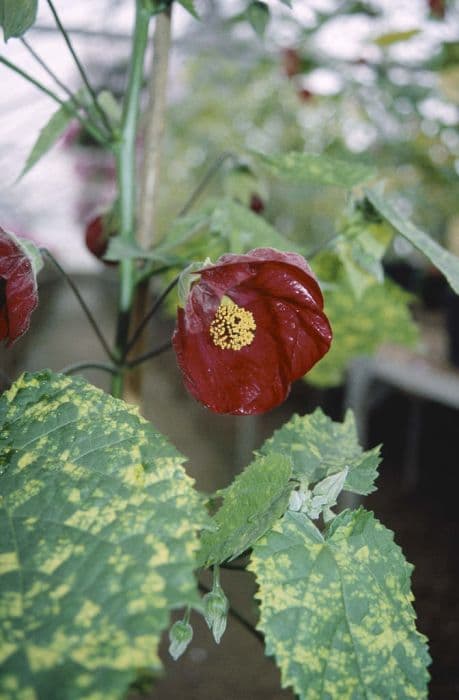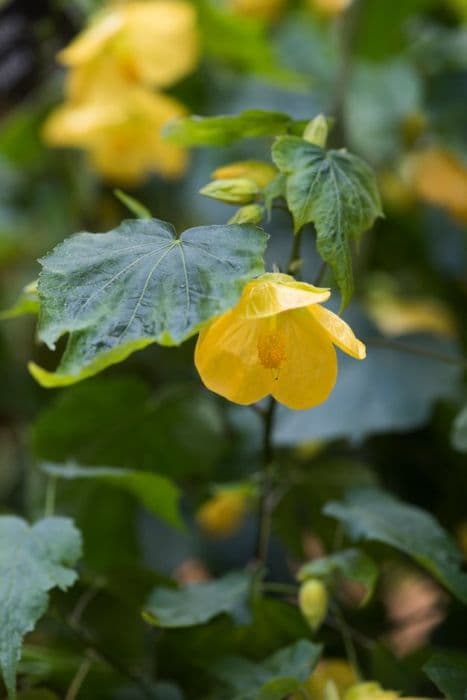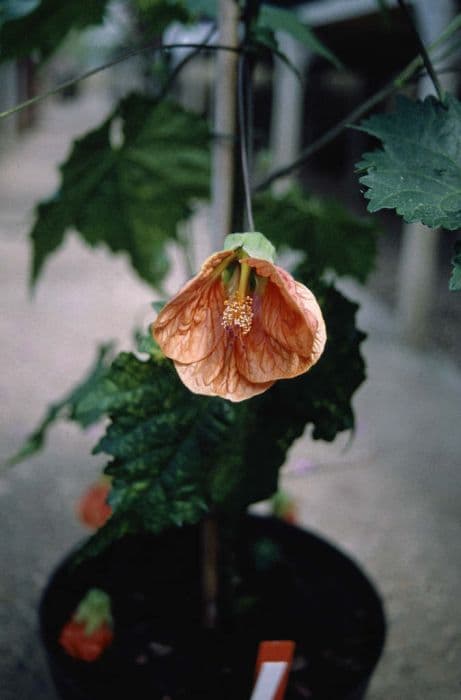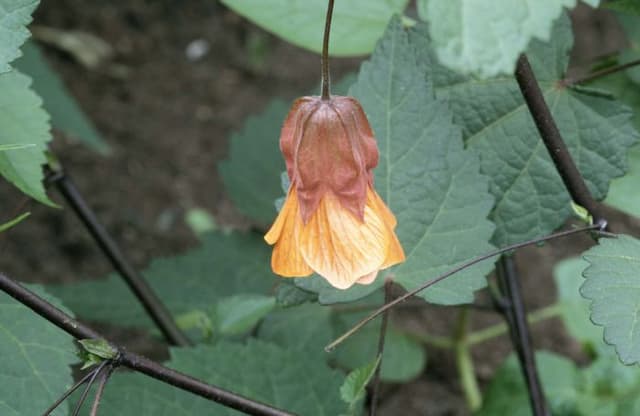Flowering Maple Abutilon 'Kentish Belle'

ABOUT
Abutilon 'Kentish Belle' is a visually striking plant, known for its unique and charming flowers and foliage that embellish the garden with color and form. The flowers of Kentish Belle resemble delicate bells or hanging lanterns, exhibiting a harmonious blend of soft yellow with hints of orange and red at the base, creating an alluring warm appearance. These bell-shaped flowers dangle gracefully from slender, arching stems, swaying gently with the breeze. Surrounding the flowers, the foliage consists of broad, heart-shaped to slightly maple-like leaves that have a rich green color, which serves as a lush backdrop to the showy blooms. The leaves exhibit serrated or saw-toothed edges and are attached to the stems by long petioles, giving the plant a somewhat open, airy aspect. Kentish Belle is appreciated in gardens for its long blooming period and the exotic touch it adds to the landscape with its drooping, lantern-like blossoms and pleasant greenery.
About this plant
 Names
NamesFamily
Malvaceae
Synonyms
Kentish Belle, Flowering Maple, Chinese Lantern
Common names
Abutilon 'Kentish Belle'.
 Toxicity
ToxicityTo humans
The Flowering Maple (Abutilon 'Kentish Belle') is not known to be toxic to humans. There is no significant evidence to suggest that ingesting parts of this plant would lead to poisoning or adverse health effects. Therefore, ingestion of Flowering Maple typically does not pose a risk of toxicity to humans.
To pets
The Flowering Maple (Abutilon 'Kentish Belle') is generally considered non-toxic to pets as well. It is not listed among the commonly known toxic plants for animals, and there is no substantial evidence indicating that ingestion of this plant would cause poisoning in pets like dogs and cats. Consequently, the Flowering Maple is not expected to have toxic effects or result in symptoms of poisoning if pets consume parts of the plant.
 Characteristics
CharacteristicsLife cycle
Perennials
Foliage type
Semi-deciduous
Color of leaves
Green
Flower color
Yellow
Height
6-10 feet (1.8-3 meters)
Spread
2-3 feet (0.6-0.9 meters)
Plant type
Shrub
Hardiness zones
9
Native area
Cultivar
Benefits
 General Benefits
General Benefits- Easy to Grow: Kentish Belle is known for being an easy-to-care-for plant that can thrive without requiring extensive gardening skills.
- Attractive Flowers: The plant produces beautiful bell-shaped flowers that add aesthetic appeal to gardens and landscapes.
- Long Blooming Season: It has a long flowering period, providing color and interest from late spring to autumn.
- Attracts Wildlife: The nectar-rich flowers attract pollinators such as bees, butterflies, and hummingbirds, promoting biodiversity.
- Versatile Use: Can be used in mixed borders, as a standalone specimen, or in container gardening.
- Drought Tolerant: Once established, it has a degree of drought tolerance, making it suitable for drier climates or water-wise gardens.
- Fast Growing: The plant is relatively fast-growing, allowing gardeners to enjoy its benefits shortly after planting.
- Pruning Tolerance: Kentish Belle can be pruned to shape and maintain its size, making it suitable for various garden designs.
 Medical Properties
Medical PropertiesThis plant is not used for medical purposes.
 Air-purifying Qualities
Air-purifying QualitiesThis plant is not specifically known for air purifying qualities.
 Other Uses
Other Uses- Abutilon 'Kentish Belle' can be used as a natural indoor privacy screen when grown in large containers and placed strategically.
- The plant's stems can be dried and woven into small handicrafts or used in basket weaving as a decorative element due to their flexibility.
- The colorful flowers of Abutilon 'Kentish Belle' can be pressed and used in art projects, such as botanical prints or for decorating homemade cards.
- You can use the plant as a teaching tool in botany or horticulture programs to demonstrate cross-breeding and hybrid vigor.
- Photographers and artists may use Abutilon 'Kentish Belle' as a subject for still life images or paintings because of its unique blossom shape and vibrant colors.
- The plant's nectar-rich flowers can be a natural way to attract and support pollinators such as bees and hummingbirds in a garden environment.
- Abutilon 'Kentish Belle' can serve as a living mulch in gardens, where its foliage provides ground cover that helps maintain soil moisture and suppress weeds.
- It can be employed in sensory gardens for its soft, velvety leaves and the subtle shade provided by its canopy, offering a tactile experience.
- Abutilon 'Kentish Belle' has a bushy growth habit that can be used to fill in gaps in garden landscapes, creating a fuller and more luxurious garden design.
- The flowers can be studied as an example of a plant with a unique pollination mechanism, due to their pendant, bell-like shape which is preferred by certain pollinators.
Interesting Facts
 Feng Shui
Feng ShuiThe Flowering Maple is not used in Feng Shui practice.
 Zodiac Sign Compitability
Zodiac Sign CompitabilityThe Flowering Maple is not used in astrology practice.
 Plant Symbolism
Plant Symbolism- Hidden Beauty: Abutilon 'Kentish Belle' often has bell-shaped flowers that hang downward, somewhat hiding their beauty. This can symbolize the idea that beauty is not always obvious and can be found within or upon closer inspection.
- Delicate Strength: The plant is both graceful and resilient, symbolizing a delicate yet strong nature—able to cope with various conditions while maintaining its elegance.
- Protection: With its broad leaves, the plant can symbolize shelter and protection, offering a haven for creatures like hummingbirds.
- Adaptability: Given its ability to adapt to different environments, from indoor pots to outdoor gardens, it may represent flexibility and the ability to thrive in various circumstances.
 Water
WaterFor the Flowering Maple, it's crucial to maintain evenly moist soil, especially during its growing season in spring and summer. Water the plant thoroughly once the top inch of soil feels dry, which will likely be about once a week. The amount of water needed can vary, but generally, a quarter to half a gallon of water should suffice for a medium-sized pot. During winter months, reduce watering frequency to every other week, allowing the soil to dry out slightly more between waterings. Overwatering can lead to root rot, so ensure good drainage.
 Light
LightFlowering Maple thrives best in bright, indirect sunlight. It should be placed in a spot where it receives plenty of light but is shielded from harsh, direct afternoon sun. A location near an east or north-facing window is ideal, where the gentle morning or filtered light will encourage blooming without causing leaf scorch.
 Temperature
TemperatureThe Flowering Maple favors temperatures between 60 and 75 degrees Fahrenheit but can withstand a range from 50 to 85 degrees. It should be protected from drafts and drastic temperature changes, which can stress the plant. The ideal indoor environment will mimic its native tropical habitat, without exposure to temperatures below 50 degrees, as cold can damage the plant.
 Pruning
PruningPruning a Flowering Maple is essential for maintaining its shape and encouraging fuller growth. Prune in late winter or early spring before the onset of new growth. Remove any dead or damaged branches, and cut back leggy stems to promote bushier growth. The plant can be pruned every year or as needed when it appears overgrown.
 Cleaning
CleaningAs needed
 Soil
SoilFlowering Maple 'Kentish Belle' thrives in a well-draining soil mix composed of two parts peat or coco coir, one part perlite, and one part compost or aged bark. This plant prefers a slightly acidic to neutral pH range of 5.5 to 7.5 for optimal growth.
 Repotting
RepottingFlowering Maple 'Kentish Belle' should be repotted every 2 to 3 years or when the roots outgrow the pot. Springtime is ideal for repotting to allow the plant to recover and grow during the warmer months.
 Humidity & Misting
Humidity & MistingFlowering Maple 'Kentish Belle' favours relatively high humidity levels, ideally between 60-75%. To maintain these conditions, a humidifier or regular misting can be helpful, especially in drier indoor environments.
 Suitable locations
Suitable locationsIndoor
Place in bright, indirect light and keep soil moist.
Outdoor
Grow in partial sun; shelter from strong winds and frost.
Hardiness zone
9-10 USDA
 Life cycle
Life cycleAbutilon 'Kentish Belle', also known as "Flowering Maple", begins its life cycle when seeds are sown and germinate, usually in warm conditions. After germination, seedlings emerge and are progressively potted up as they grow. The young plants then mature into bushy, evergreen shrubs; it's during this vegetative stage that the distinctive maple-like leaves develop. The flowering stage follows, where bell-shaped, pendulous flowers bloom periodically throughout the year, typically peaking in the summer months. After pollination, which is often assisted by insects, the plant produces seeds that can be collected for propagation. As a perennial, the 'Kentish Belle' may enter a period of dormancy in colder climates but generally maintains its leaves if the temperature does not drop too low, resuming growth and flowering in subsequent seasons.
 Propogation
PropogationPropogation time
Spring-Early Summer
Propogation: The most popular method of propagation for the Abutilon 'Kentish Belle', commonly known as the Flowering Maple or Chinese Lantern, is through semi-ripe stem cuttings. This technique is typically conducted in late summer. To propagate, a gardener should select a healthy, semi-ripe stem and cut a piece about 4 to 6 inches (10 to 15 centimeters) long just below a leaf node. The lower leaves are removed, and the cutting may be dipped in rooting hormone to encourage root development. The cutting is then placed in a pot filled with a mix of peat and perlite. The environment should be kept humid by covering the pot with a plastic bag or placing it in a propagator, and maintained at a temperature of about 70°F (21°C). Roots often form within several weeks, after which the new plants can be gradually acclimatized to less humid conditions before potting on.





![Abutilon [Yellow Trumpet]](/_next/image?url=https%3A%2F%2Fplants-admin.emdemapps.com%2Fimages%2Fplants%2F%2Fimages%2F604b5caa8b4fb.png&w=640&q=75)


